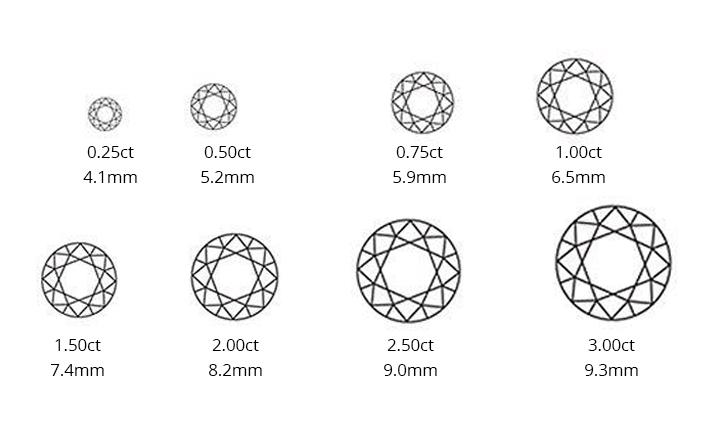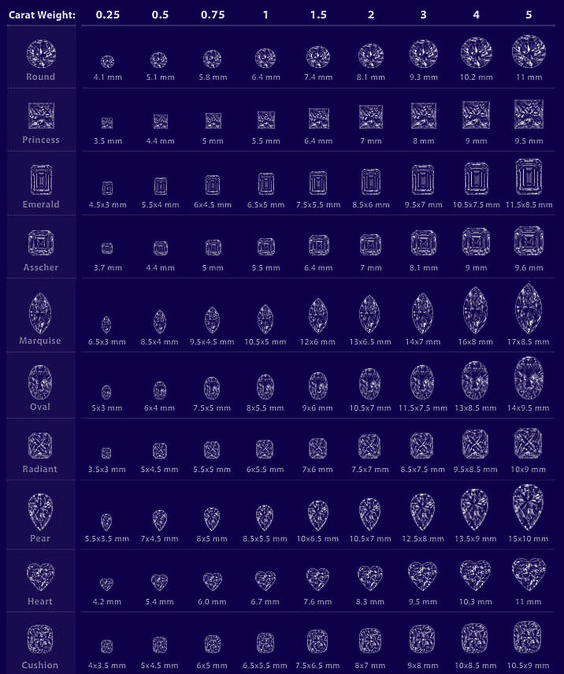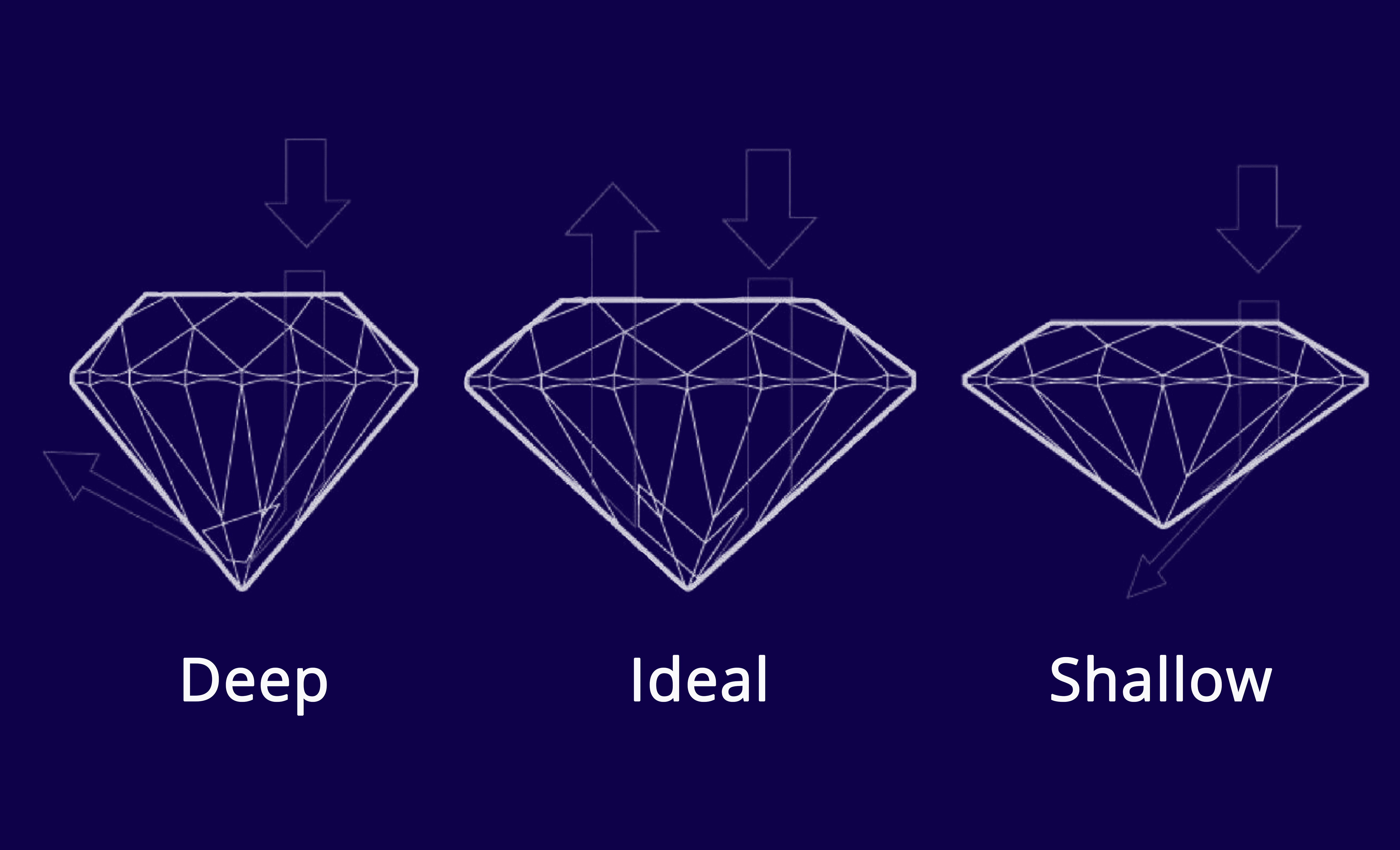There are 2 most common mistakes people make about diamonds:
Why are these two assumptions false? Because here's the truth:
Why is it so? The classic diamond size chart clarifies the relations between length, width, and carat size of a diamond.

Diamond size chart
As you see in this table, the dependence between a diameter and a carat number of a diamond exists. But this change is unpredictable.
For example, the difference between a 1 and a 1.5-carat diamond is 0.9 millimeters. If you compare a 2 carat and a 2.5-carat diamond, the divergence equals 0.8 millimeters. But the difference between a 2.5 carat and a 3-carat diamond is 0.3 millimeters surprisingly.
In all the cases, the change in carat size is 0.5 carats. But the diameter in millimeters changes by 0.3-0.9 mm without any consistency!
| A 2 carat diamond is NOT twice bigger than a 1 carat diamond |
Thus, the only way to predict the carat number from a diamond diameter is to check the diamond carat size chart. Knowing this table can come into practice in different situations. For example, you can evaluate the carat size of any diamond by yourself. Or imagine how a diamond will look on your finger and how many carats you want it to be.
Here's a terse instruction to get an insight into the diamond carat size from its appearance:
surprisingly
.
But again: the carat size from the table is simply a rough idea about the diamond weight. Only a specialist can evaluate the stone and tell you its accurate number and real value.
The carat weight is not the ultimate factor that determines the diamond value. The sophisticated interplay between various elements results in its beauty and elegance. And the diamond shape is one of them.
A diamond shape is a specific form of a diamond cut. It makes the jewel look like a teardrop or a heart, for example. By introducing uniqueness, this new diamond appearance ruins the classic proportions of a round-cut diamond. To make the unified system for measuring diamond shapes other than round one, the specialists rely on the length to width ratio instead of a diamond diameter.
That's how a classic diamond size chart has extended into the cut diamond size chart you see below. The table below lists the diamond carat size for a variety of shapes.

If your diamond is not round-shaped, check its carat weight in this cut diamond size chart
If diamond carat is not as important as you thought, what is it all about?
A carat of a diamond is the measurement scale for its weight. More than 110 years ago, the diamond industry leaders decided that 1 carat equals 200 milligrams. Since then, this formula became a basic metric for determining carat weight.
Also, carat is one of the 4Cs of a diamond. Along with clarity, cut, and color, it defines the value of a jewel. It's the easiest parameter to understand. Thus, customers tend to think that knowing carats means knowing everything needed about the diamond.
But the reality is that the carat is not easy to measure and is not the only important diamond factor.
| "Carat" is about diamond weight, not it's size! |
So, when we use "carat size," we mean the weight of a diamond. Also, this term refers to the result you find in a diamond size chart.
Diamond size is the diameter of a stone in millimeters. For the diamond shapes other than a round one, it's calculated by measuring the length and width ratio.
In the diamond size chart, you can use this parameter to define the carat size of a jewel. You should always check it. Carat weight is more important than its diameter because it allows making conclusions about its possible price.
Knowing the exact carat size of one diamond requires special equipment. And if you try to compare several stones, this task becomes even more complicated. You can get the idea about this parameter by checking each stone in the diamond carat size chart, though.
Nevertheless, it's tricky. The diamond size doesn't change with the carat size proportionally. As you can see in the diamond carat size chart, a jewel of 6-carat weight is not three times bigger than a 2-carat diamond. In reality, these stones are 11.7mm and 8.2mm, respectively.
This rule works if only you compare two round-cut diamonds. To compare diamonds of different shapes, you should refer to the cut diamond size chart.
But why do you need this information? It's simple: the weight of a diamond determines its true value. You should find out the exact diamond carat size, not superficial measuring of its diamond size, to check the diamond price.
|
1 carat ≈ 6.5 millimeters in diameter, |
The answer depends on the tasks you have for a diamond.
For example, you go shopping for a diamond engagement ring. In this piece of jewelry, the setting and the shape determine the diamond appearance. So, select the jewel of a diamond carat size that is big enough and noticeable to get value for your money.
Here's the most universal advice possible: Consider both the diamond size and its carat weight ALONG WITH many other factors. This will make your decision informed.
Any diamond task requires the eye of a professional who has both diamond and jewelry knowledge. You can contact such experts in Diamond Registry — just fill the contact form below!
Seven times out of ten, the classic diamond size chart is enough. This table is designed for round-cut diamonds and contains all the information needed. The majority of diamonds have this shape — three fourth of the entire diamond market, to be precise.
So, if you can't determine which shape your diamond has — it's likely to be a round one.
If you're shopping for fancy-shaped diamonds (oval, heart, pear cuts, etc.), check the diamond size chart of the cut you've chosen. That will lead to better accuracy.
| The diamond size chart is suitable for 75% of diamonds worldwide |
Unfortunately, the diamond size chart cannot determine the precise carat weight. All the marks mentioned in the carat size chart are created for the stones of a perfect length to width ratio.
And such a perfect ratio is remote from reality. Frequently, diamonds don't have an ideal cut.

How the cut quality can change the length and width of a diamond
Cut quality changes the diamond diameter — and a worse cut can be tricky by making a stone bigger. Otherwise, a good cut can contradict with a bigger carat size.
Anyway, the cut should become your priority. Everybody loves diamonds for sparkle and brilliance. But going for a bigger glassy rock will spoil all the marvelous effect of this jewel. So, while shopping for a diamond, keep in mind that its price depends on the cut quality and carat weight, not the diameter.
The number of millimeters can help you imagine how big diamonds will appear on your finger and in your ears. This can be useful before and while visiting a jewelry shop.
So, you have the secret tool for checking the diamond price accuracy — a metric scale. Now, you're prepared for visiting jewelry shops and checking the diamonds like a pro!
Alternatively, you can save your precious time by referring to Diamond Registry specialists. We'll be happy to help shopping for a diamond! Just fill out the Free Quote request form, and don't waste time measuring each diamond with a metric scale. We'll do this job instead of you.

